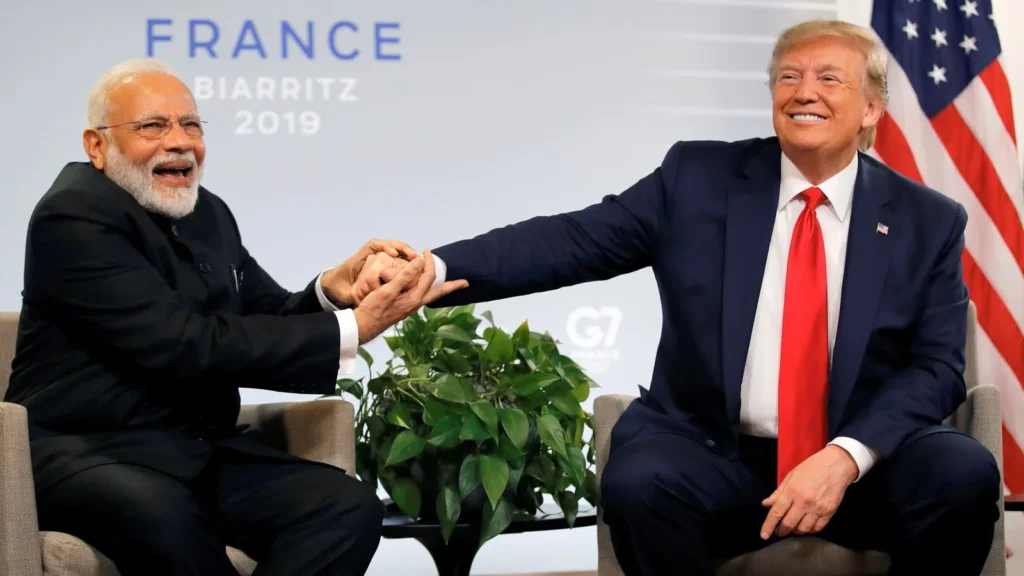US Tariffs on India: Markets Decline as US Imposes 27% Tariff on Indian Imports
Indian equity markets experienced a sharp decline on Thursday, April 3, 2025, after the United States imposed a 27% reciprocal tariff on Indian exports. The move, part of the Trump administration’s strategy to address trade imbalances, comes amid concerns over India’s high import duties on American goods. Analysts believe this decision could alter the long-term trade dynamics between the two nations, with ripple effects across multiple sectors.
The Impact on Indian Markets
Following the announcement, the BSE Sensex fell by 378.60 points (0.49%) to 76,238.84 in early trading, with an intraday low of 75,807.55. The NSE Nifty also dropped 80.60 points (0.35%) to 23,251.75.
IT stocks bore the brunt of the decline, with Tata Consultancy Services, Infosys, Tech Mahindra, and HCL Technologies emerging as major laggards. Other key losers included Tata Motors, Adani Ports, Bharti Airtel, Reliance Industries, and Kotak Mahindra Bank. Meanwhile, Sun Pharmaceuticals, NTPC, Titan, and PowerGrid managed to gain despite the broader market downturn.
Market experts suggest that the uncertainty surrounding global trade policies could lead to further volatility in the coming weeks. Investors are likely to reassess their portfolios, focusing on domestic demand-driven sectors to minimize exposure to external trade risks.
Why Did the US Impose Tariffs?
The US government has justified the 27% tariff by arguing that India levies high import duties on American goods, creating an uneven playing field for US exporters.
On Wednesday, April 2, 2025, former US President Donald Trump announced that more than 180 countries and territories, including European Union nations, would face similar tariff measures under his administration’s new “reciprocal tariff policy”.
Experts believe the move aims to boost US manufacturing and reduce the country’s trade deficit. However, analysts note that India is better positioned than some of its competitors, who are facing even steeper levies. Some observers argue that the move is also driven by domestic political considerations, as protectionist trade policies remain a key talking point in US elections.

India’s Response and Next Steps
The Indian government is reportedly evaluating multiple counter measures to mitigate the impact of these tariffs. Possible responses include:
- Tariff Reductions: Reviewing import duties on key American products to ease trade tensions.
- Negotiations with the US: Engaging with US trade officials to seek exemptions or tariff reductions.
- Boosting Export Competitiveness: Exploring incentives to support Indian exporters affected by the tariff hikes.
- Diversifying Trade Partnerships: Strengthening trade agreements with the European Union, ASEAN nations, and emerging markets to reduce dependence on the US.
Trade experts caution that any retaliatory actions from India must be carefully calibrated to avoid escalating tensions further. Maintaining diplomatic channels while protecting domestic industries will be crucial in the coming months.
Global Market Reactions
The tariff announcement had global market repercussions, with major Asian indices reflecting similar declines:
- Tokyo’s Nikkei dropped over 3%.
- Hong Kong’s Hang Seng fell 2%.
- Seoul’s KOSPI declined 1%.
- Shanghai’s Composite Index dipped 0.39%.
Despite the downturn, US markets closed higher on Wednesday, signaling investor confidence in domestic economic policies. However, industry leaders warn that a prolonged trade standoff between major economies could slow global growth, affecting supply chains and investment flows.
What’s Next for Indian Exports?
The Indian export sector—especially industries such as pharmaceuticals, textiles, and IT services—could face short-term disruptions due to the tariff hike. However, India’s diversified export portfolio and ongoing economic reforms may help cushion the long-term impact.
To counteract potential losses, Indian companies are expected to restructure supply chains, explore alternative shipping routes, and negotiate pricing adjustments with key trade partners.
The government may also introduce additional policy incentives for export-driven industries, ensuring they remain competitive despite the added costs. Financial institutions could step in with low-interest trade finance solutions, helping businesses navigate the immediate challenges posed by the tariffs.
As the situation unfolds, experts suggest that a proactive policy response from Indian authorities will be essential to navigate the evolving trade landscape and safeguard economic stability. The next few months will be critical in determining whether India and the US can find common ground or if global trade dynamics will undergo a significant shift.


